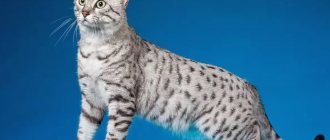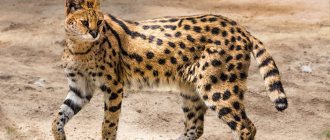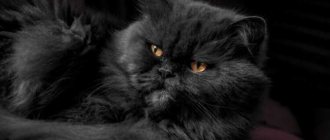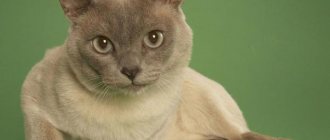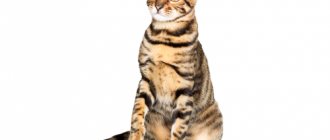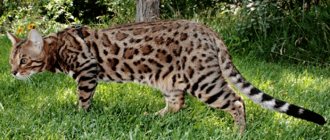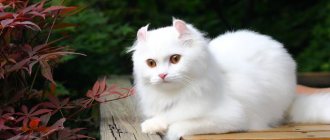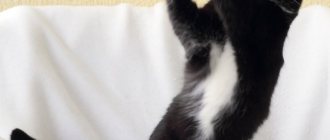Features of a healthy diet
Basic Rules
The daily diet of the Serengeti should be balanced, nutritious, enriched with various vitamins, minerals, macro- and microelements.
When compiling it, follow the simplest tips. Feed young kittens exclusively warm food. Cold food negatively affects the digestion process, while excessively hot food causes a burn to the mucous membrane of the esophagus and stomach. The number of meals up to 6 months is on average 5-6 times a day in small portions of 100-150 g
At an older age, reduce their number to 3-4 times a day: 200-300 grams in the morning, afternoon and evening. Pay special attention to drinking plenty of water: change the water daily, after washing the bowl with laundry soap. A kitten's diet (especially during adolescence) should contain a sufficient amount of protein products. Introduce turkey, chicken, and rabbit fillets to the menu. Do not mix dry food and natural food to avoid heaviness and intestinal obstruction. Determine a special (one) place for feeding, do not move the bowl around the house.
Dry food
Modern dry food comes in the form of granules. They contain all the necessary macro- and microelements, vitamins, minerals necessary for the proper physical and mental development of the animal. The most popular:
- Purina One;
- Kitekat;
- Friskies;
- Perfect Fit;
- Darling;
- Royal Canin;
- Felix;
- Brit Care;
- Dr.Clauders.
Canned food
Canned food is a common commercially prepared cat food option. This product is available in the following variations:
- mousse - often used for the first feeding of kittens; the ingredients included in its composition are highly ground and have an airy texture;
- pate – has a denser consistency, the components are ground until smooth;
- chopped meat - finely chopped pieces of turkey, chicken, rabbit, veal;
- stew - made from fish, offal and meat fillet, filled with sauce or jelly-like gravy.
Canned products are packaged in soft bags, tin and glass jars. The most popular brands:
- Pro Plan;
- Felix;
- Country delicacies;
- Sheba Pleasure;
- Hill's Science Plan;
- Royal Canin.
Treats
Healthy treats for cats are meat protein enriched with vitamins and minerals, available in the form of:
- dried pieces of meat or fish, cream soups and puddings - used as treats and praise during training;
- crispy pads, sticks - used to remove hairballs from the stomach;
- vitamin granules – prescribed on the recommendation of a doctor to replenish the required amount of minerals in the animal’s body.
The most widespread are:
- Dreamies;
- Beaphar;
- Edel Cat;
- Mnyams;
- Country delicacies;
- Happy Cat.
Natural products
For healthy growth and normal functioning, introduce natural food into the Serengeti diet. The most useful and safest are:
- lean meats - veal, turkey, chicken, rabbit;
- offal – chicken and beef liver, stomachs, hearts, kidneys;
- sea fish - salmon fillet, trout, salmon;
- dairy products - fermented baked milk, sour cream, kefir, natural yogurt, boiled cow's milk, cottage cheese;
- chicken eggs;
- hard and curd cheese;
- vegetables - broccoli, cauliflower, zucchini, pumpkin, Brussels sprouts (boiled or stewed);
- cereals – oatmeal, buckwheat, rice, millet;
Forbidden food
Exclude the following foods from your pet's menu:
- bakery and confectionery products;
- chocolate, sweets;
- nuts;
- legumes;
- pickles, smoked and spicy foods;
- sausages, frankfurters, sausages, cutlets;
- pork, lamb, cartilage, bones;
- fruits;
- frozen semi-finished products.
Serengeti are amazingly affectionate, loyal and friendly creatures. You have become familiar with the basic rules for caring for and maintaining this breed, as well as the principles of creating a balanced diet. Try to surround your pet with warmth and care from the first day of his stay in your home.
Feed and health
It is recommended to use high quality food, although a natural method of feeding your cat is also suitable. However, too soft food is fraught with the appearance of tartar.
On average, the Serengeti lives 12-15 years, remaining active into old age and maintaining leadership qualities. Adults give birth to 3-8 kittens. This amount of offspring is quite rare for purebred species.
Interesting facts about the Serengeti
The most accurate word that expresses the character of the Serengeti breed is eccentricity; these animals are very inquisitive and have a perky disposition. Before you bring home a Serengeti, it is worth getting to know this breed better.
- Experts do not recommend having a Serengeti in a family with small children.
- When a Serengeti couple has kittens, they become exemplary parents. They are happy to teach their kittens to go to the litter box and eat like an adult, immensely caring for their babies.
- Serengeti cats have a special love for walks in the fresh air. Fleeing to the streets is a common occurrence; after several days of absence, fugitives always return home.
- Any objects in the apartment can become a toy for curious cats.
Health characteristics and common diseases
This breed of cat has an increased predisposition to urolithiasis. It is important to identify and prevent the disease over time.
- You also need to know that females get this disease much less often than males. In addition, the disease proceeds completely unnoticed, the animal does not show any alarming signs, no symptoms are visible, but a sudden malaise immediately appears.
- For example, the first signal that needs to be taken into account is when a Serengeti cat cannot go to the toilet for a long time; when licking the genital opening, the animal meows pitifully, the animal urinates somewhere before reaching the toilet.
There may be other signs of abnormal cat behavior. Self-medication in this case will not bring the desired results and can only worsen the situation. Only a qualified veterinarian can eliminate this disease.
Character traits and level of intelligence
Servals are predators by nature. They may exhibit the unbridled nature of their wild ancestors. To prevent imitation of its relatives from becoming the norm of behavior, the kitten needs to be educated and its behavior corrected from childhood.
You need to talk to your pet a lot, play with it, encourage it, and patiently but persistently point out its misdeeds. Thanks to its intelligence, the kitten will very quickly learn to understand what is “good” and what is “bad”. It is best to play on the floor, where the eyes of the owner and the cat are at the same level. By contacting in this way, it is easier to create an atmosphere of trust and friendship. Games and running should not only be allowed, but also encouraged - the domestic cheetah should be active.
- Let's play!..
Important! Punishment should never be aggressive! You can’t shout, much less hit an animal!
These creatures are endowed with high intelligence, and judging by their habits, the African Serval is half dog: faithful, devoted, and easy to train. He quickly remembers and follows his owner’s commands and likes to walk a lot. Accustomed to a leash since childhood, the domestic predator does not resist it and perceives this accessory absolutely calmly.
A cat living in a family loves to communicate with people, is a devoted and loyal friend, and always looks forward to their return home. And so that she does not get bored alone, does not chew things, shoes, wires from electrical appliances (which is not only damage, but a direct danger to the life of the animal), you need to buy toys for her that can be chewed, fiddled with, nibbled, thrown, caught.
To discourage your pet from an item he likes, treat it with aromatic sprays that are safe for pets, which are sold in pet stores.
Remember! It is impossible for the kitten to perceive the owner’s hands or feet as moving toys. The cat will quickly grow up, its teeth, paws and claws (even if treated) will become stronger. A cat excited by a playful environment may not be able to control its hunter's reflexes.
Jumping, running fast, loving to overcome various obstacles and conquer all kinds of heights, the African Serval cat amazes with its energy, agility and readiness for new records.
Exotics are naturally excellent swimmers; they love swimming and playing in the water. They are not known for their courage - they would rather run away from danger and hide than show aggression.
It is recommended to purchase a bush cat only for owners of a large house or a very spacious apartment, where you can allocate a whole room for the cat, which serves as a playroom, gym and place for relaxation. It must be remembered that this is a large wild cat that requires a lot of space.
You need to make sure that the animal does not jump from a great height, because its leg bones are quite fragile. This is especially true for kittens.
In their natural environment, predators feed on rodents, fish, birds, shrews, and reptiles.
Shrew
The basis of the diet of the domestic serval is meat. It's good when the meat is with bones. The daily intake of this product ranges from 0.5 kg to 1.5 kg, depending on age. The cat is fed 2 times a day with the following foods:
- lean poultry (chicken, turkey, quail), veal, beef;
- quail eggs;
- offal;
- greenery;
- vitamin and mineral supplements containing calcium;
- Fresh and clean water is needed daily.
You can feed ready-made Super-premium food.
Reviews
“We got a cat of such an extraordinary breed two years ago. And he immediately became everyone’s favorite. At first, his high jumps scared me, but then I got used to the fact that Cupcake could jump onto a cabinet right from the floor. He loves large spaces, as his games are very active. Children adore him, but the cat is not far behind in his expressions of affection. He loves to cuddle and get attention. An ideal breed for families with children.” Ekaterina M., Veliky Novgorod
***
“The Serengeti breed does not like loneliness very much. When I returned to work after maternity leave, our one-year-old kitten took it very hard. Neither me, nor my husband, nor the child were at home for days on end, and Thomas became sad. And we decided to take him a girlfriend. We bought a cat of the same breed and now the two of them are having a great time. Two small, luxurious beauties with the appearance of wild predators invariably cause a sensation when we go for a walk with them. They feel great on a special leash and love the compliments of others." Olga., Podolsk
Description of the species
The secretive lifestyle of the black-footed cat limits observation of it in its natural habitat. Scientists make their assumptions about representatives of the species based on observations of animals kept in captivity - but the behavior of a wild cat in nature can differ significantly from its “captive” image.
External data
The weight of the small predator rarely exceeds one and a half kilograms, the average body length is half a meter - the length of the tail is 10–20 centimeters. The black-footed cat has a strong, stocky body, a large round head and huge, very expressive eyes, flickering in the dark with an infernal bright blue light. The animal has excellent vision at night, has sensitive hearing and a keen sense of smell.
In the twilight, the eyes of a wild cat glow with blue light
The main color of the coat can vary from light sand to reddish-brown; against this background there is a “wild” pattern of black spots, sometimes merging into stripes. The camouflage coloring perfectly camouflages the wild African cat, making it invisible to both enemies and prey. The paw pads below are reliably protected by dense fur from the hot desert sands.
The art of camouflage for the black-footed cat is a matter of survival
Character and lifestyle
Wild African cats do not build shelters for themselves - they develop ready-made rabbit holes or even termite mounds. They also occupy the burrows of other animals - porcupines, striders or aardvarks, having previously expelled their previous owners from them or simply eaten them for lunch. In these secluded and well-protected places, predators prefer to sit out during daylight hours, and at dusk they go out hunting, walking up to ten kilometers per day. They tolerate both heat and drought well and can go without water for a long time, getting moisture from food.
During the day, the predator sleeps in a shelter, and at night it goes hunting
The hunting grounds of males can reach fifteen square kilometers, while the territories controlled by females are usually three to four times smaller. Animals regularly mark their borders and jealously protect them from strangers.
A wild African cat jealously guards the boundaries of its possessions
Video: life of a black-footed cat litter in natural conditions
Nutrition
The diet of the black-footed cat is quite diverse - it includes up to fifty different types of prey: rodents, birds, insects, reptiles and amphibians. A brave predator is not afraid of the size of the prey, and she easily decides to attack an animal twice her size. Moreover, such an attack is most often successful.
The black-footed cat has a good appetite and attacks even animals twice its size.
Reproduction
During the period of love games, a cat and a cat, who the rest of the time lead a solitary lifestyle, unite in a pair. In due time - after just over two months - the fruits of love are born. There are most often two kittens in a litter, but in general there are no more than four. The mother raises and raises them independently, without the participation of the second parent.
The black-footed cat is a caring mother who raises kittens on her own
Kittens are milk-fed for up to one and a half months, but the cat begins to treat them to fresh meat quite early. By the age of five months, children reach the dimensions of an adult animal, but for another two to three months they live close to their mother, until they become completely independent. Full sexual maturity of young animals usually occurs by one year or a little earlier.
Reproduction and lifespan
Cats are ready to breed at the age of 8-9 months, but the first mating is recommended at 1.5-2 years. In a pair, it is desirable that one animal is untied, this way mating is more successful. It is not easy for a female to find a partner, since in good nurseries, rare breed cats are sold already neutered.
When searching for a partner, it is important to take into account the presence of a veterinary passport, the animal’s pedigree, and even the partner’s blood type. As a rule, only experienced nursery workers are trusted to breed a unique breed. Pets must be provided with a separate room during marriage and, most importantly, not interfere with the process.
In a litter of purebred Serengeti cats there are 3-5 kittens, which is a rarity among the cat elite. Breeders urge not to breed a cat more than twice in three years. After giving birth, the female needs recovery for 10 months. Frequent childbirth exhausts the body and shortens the animal's life.
Serengeti cats are caring mothers, and not a single kitten is deprived of her attention. Immediately after birth, the babies are blind and deaf. They begin to see sight after about 10 days, and begin to hear after 12 days. The Serengeti kitten is ready for sale and transfer to new owners in 3-4 months.
Pets live 13-15 years. Animals retain their love of life, playfulness, and activity until old age. Their leadership remains until the last day. Over the course of their allotted lifespan, pets become real family members and friends.
History of the Serengeti breed
The serval wild cat lives in Africa, which has been attracting cat lovers for many years with its unusual appearance. This animal is the closest relative of lynxes and caracals, but is more similar to a cheetah. Servals are tamed and kept as pets, but with great restrictions, since they remain predators even in a human home.
Serval is a bush cat from Africa that looks like a small cheetah.
Breeders dream of a cat similar to a serval, but more friendly and flexible towards humans. The most famous way - crossing wild animals with domestic ones - was tested several years ago, resulting in the Savannah breed. These cats are expensive and beautiful, but there are too many problems in breeding them. The first generation of male hybrids is mostly sterile, and without the infusion of wild serval blood, after several generations the cats lose their resemblance to predators.
The Savannah breed was developed by crossing Servals with domestic cats.
American breeder Karen Sauzman found another way out. She decided to breed a domestic cat similar to the serval, using not predators, but already existing purebred cats. In this case, the phenotype (appearance) of the serval should serve as a guide, especially such features as the length of the paws, the size of the ears, coat color and much more. For this, from her point of view, the Bengal and Oriental Shorthair breeds were suitable. Bengals were expected to have solid weight and bright colors, while Oriental Shorthairs were expected to share their long legs, large ears, and overall delicacy. The spotted color of both cats also came in handy. In subsequent generations, Maine Coon and Abyssinian breeds were also used. In 1994, the first Serengeti were born. The word Serengeti itself refers to a protected area in Tanzania where servals and many other wild animals live. This is the name Karen took for her new breed.
Serengeti is a savannah national park in Tanzania, home to a huge number of African animals.
Serengeti cats turned out to be really similar to servals, without having wild serval blood. The breed is quite young, considered experimental, and has official status only in the international association TICA. However, she cannot take part in exhibitions, because, according to the requirements of felinological organizations, at least 50 nurseries must be organized for this, and so far there are much fewer of them. Work on the Serengeti is still ongoing, crossing with other breeds is allowed.
Table: pros and cons of the Serengeti breed
| Pros of the Serengeti | Cons of the Serengeti |
| Attractive appearance | Too large size for small apartments |
| Easy to care for and unpretentious in food | Experimental breed (work in progress) |
| Good health | Excessive activity and curiosity |
| Friendly and loving character | Talkativeness of animals (can tire owners) |
| Unexcitable and confident temperament | Rarity and high price of real Serengeti |
| Attachment to home and lack of tendency to wander | Inability to participate in exhibitions (not recognized by all felinological organizations) |
History of the breed
As you know, African jungles and deserts are not the homeland of the Serengeti; America is considered its homeland. The founder of the breed, Karen Southman, worked in a wild animal reserve in the 90s of the 20th century. The inhabitant of the reserve, a wild cat belonging to the Serval breed, simply charmed Karen. And she decided to repeat all the beauty and charm of a wild cat in a domestic one, but with the condition that the servals should not independently participate in the expansion of the population.
Karen Sauzman decided to crossbreed an Oriental Shorthair cat with a Bengal cat. This decision was not without reason, because four years of in-depth analysis and research work formed the basis of her choice. All these years she carefully selected breeds, all animals were subjected to ultrasound examinations for the presence of diseases. And this work today is priceless, because Serengeti cats are among the most expensive cats in the whole world, and not only due to their number.
On a global scale, this cat breed is not bred en masse; only a few dozen geneticists are known who breed the Serengeti.
What does a typical breed look like?
The Serengeti have a large, lean body and an athletic build. The back line is straight, the chest is deep. The limbs are muscular, very strong, with powerful claws. They hold the record for the length of their paws among domestic cats. The length of the tail is equal to the distance between the croup and the shoulder blades; the tail itself is strong and mobile. Weight averages 12 kg. The weight of cats starts from 8 kg, and the weight of cats can reach 15 kg.
The neck is long, muscular, smooth in outline. The head is medium-sized and has an elongated wedge-shaped shape. The profile of the frontal-nasal part of the skull has a straight line, the cheeks are flat. The ears are wide, set high, close and vertical, with rounded tips. Ideal proportions are considered to be equality between the height of the head and the length of the ears. The eyes are round, medium in size, yellow-copper in color, very expressive thanks to the black eyelids. The nose is equally wide throughout its entire length, and the chin is graceful.
Colors:
- black;
- smoky with a spotted pattern;
- tabby based on black, brown and silver shades;
- aka lynx-point - this option is in development and looks like large dark spots on the ivory-colored coat.
The spotted pattern is located chaotically, round and horizontally elongated spots are acceptable. The coat is short and quite soft, the presence of shine is welcome, as long as it does not reduce the contrast of the pattern.
The Serengeti breed meets the standard of the International Cat Association and is included in the TICA list of experimental breeds, but is not yet approved. The selection is far from complete, while some breeders today are working to improve the breed with an emphasis no longer on the external qualities that Karen Sauzman tried to strengthen. In particular, this concerns the size and shape of the ears. The original idea was to breed cats with large, pointed ears, but now the opposite trend is observed.
Catering
A balanced diet is the key to your pet’s health and good mood. Therefore, decide as quickly as possible what you will feed him: industrial feed or natural food?
It is not recommended to combine one with the other, just as it is not recommended to jump alternately to one or the other.
Natural products
Natural food must be of high quality and fresh, prepared according to the recommendations of veterinarians. The menu should include the following products:
- Meat: veal, beef, rabbit, lamb, poultry (chicken, quail, turkey). It is given raw (after freezing) or boiled (the latter option is worse, since cooking destroys a number of vitamins).
- Porridge: rice, oatmeal, pearl barley, millet, buckwheat, semolina. The porridge is cooked in water (only semolina for babies - in milk), without adding anything other than half a teaspoon of vegetable oil (olive, sunflower, flaxseed).
- Dairy products: yogurt, fermented baked milk, sour cream, low-fat cottage cheese, bio-yogurt.
- Vegetables: zucchini, carrots, pumpkin, asparagus, broccoli. Allows greens: green salad, dill, parsley. Vegetables can be given raw, but most often cats turn their nose up at raw ones. Therefore, stew them or boil them, chop them finely and mix with porridge and meat, add to meatballs and cutlets.
- As a treat, cats can be given a cucumber, apple, pear, watermelon or melon to chew on.
It is better not to give fish to cats of the Serengeti breed: due to kidney problems in representatives of this breed.
Your cat should always have clean water in a separate bowl. You cannot give your animal liquid from the tap: tap water can be too hard or saturated with chlorine, and contains an admixture of salts and other components that are dangerous for cats. Leave the water in a container without a lid for 10-12 hours, buy purified water in a store or pass it through a household filter.
Recommended food
If you choose ready-made food, remember: you should only buy food from the holistic and super-premium classes. They are made from high-quality products (meat, fish, vegetables, berries, fruits) in compliance with all necessary standards, they retain the maximum amount of vitamins and nutrients. Wildcat, Akana, Kanagan, etc.
Premium and, especially, economy food, despite loud advertising slogans, is of much worse quality. Instead of pure meat, they use meat waste (and since there is no decoding on the packaging, this can mean anything), artificial preservatives, unsafe dyes, flavor enhancers, but there are practically no useful components there.
| Holistic | Super premium | Super premium |
| Wildcat | Trainer | Husse |
Contents of the Serengeti
The Serengeti is unpretentious, and caring for them consists of the usual procedures: combing, cleaning ears and eyes, timely deworming and vaccination. As for nutrition, this issue must be approached seriously, since the health of purebred cats is determined to a large extent by their heredity and diet.
Nutrition
When choosing a diet for the Serengeti, you need to decide whether it will be fed with natural products or prepared food. Veterinarians and breeders consider super-premium and holistic food to be the best option, because they save the owner’s time and effort, and the content of nutrients and vitamins in high-quality food is higher than in natural food.
Ready-made professional food will provide adequate nutrition for the pet and save time on preparing food for the owner
If you are still planning a diet based on natural products, then it should be developed with the participation of nutritionists for animals and contain not only meat, but also other products, and you will have to cook for your pet separately. Food must be fresh and of high quality. Salt, sugar, spices and other food additives, as well as fried and smoked foods, are not allowed in the diet. Under no circumstances should you offer your cat flour products and fish, as this provokes the development of urolithiasis.
Quantity and composition of food
When feeding natural products, 60% of the Serengeti diet should be meat, and only beef or veal. You also need to give cats poultry (chicken, turkey), cereals, vegetables, dairy products and eggs. The meat should be boiled and lean, so pork is excluded. It is definitely worth supplementing the diet with vitamin and mineral complexes for cats that can compensate for the lack of nutrients in food. A veterinarian will help you choose a vitamin preparation. When eating natural foods, tartar or other problems in the oral cavity may appear. For prevention, you can sometimes let your pet chew dry food or cartilage. Bones should not be offered, it is harmful to the health of the Serengeti.
It is imperative to include vitamin supplements for cats in their natural diet, since it is very difficult to get everything they need for health from regular food.
Most breeders feed the Serengeti with high-quality ready-made food, both dry and wet. It is better if it is premium or super premium food for large active cats. Representatives of this breed have a valuable quality: they are not prone to overeating and obesity. Therefore, dry food can be left freely available, the pet will eat as much as it needs. If your Serengeti differs from its relatives in having a more excessive appetite, then food should be given in doses. The approximate amount per feeding is indicated on the pack depending on the weight of the animal.
How many times a day should you feed your pet?
Adult animals are fed twice a day, morning and evening. Pregnant and lactating cats and kittens should eat more often - 3-4 times a day, with special food with a higher calorie content.
Your pet should always have free access to fresh, clean water. When feeding dry food, the animal needs to drink a lot, this is a factor in preventing the formation of kidney stones.
If your cat prefers to drink tap water, it is better to equip it with a filter so that the water is clean and healthy.
It is very useful to provide your cat with fresh grass, whether you grow it yourself or buy it from a pet store. Animals need grass as a vitamin supplement and for good digestion. This way, indoor plants will be protected from attacks.
The role of a balanced diet in cat health
Proper nutrition is important for the Serengeti as these animals are prone to urolithiasis. Foods containing salt, sugar, and harmful food additives can trigger an attack. Low-quality dry food can also lead to numerous diseases. Therefore, the diet should be thoughtful and balanced, agreed upon with a veterinarian or an experienced breeder. It must be borne in mind that there are special foods for animals already suffering from kidney or bladder diseases, or diets with a preventive effect. It is to them that the animal should be transferred in the event of the appearance of specific chronic diseases.
Many well-known food manufacturers have special product lines for animals suffering from certain diseases.
Video: how to choose quality cat food
Appearance care
Serengeti cats do not require complex care; they are very clean and take good care of themselves. You need to regularly examine your pet and clean its eyes and ears if necessary, and at least sometimes take your pet to the veterinarian for examination.
Brushing and bathing
The Serengeti has short and thick hair that does not form tangles, so it is not necessary to comb your pet with a comb. But regular massage with a silicone or rubber brush will remove excess hair and activate blood circulation. It is enough to carry it out once every 10–14 days; it is better to get used to this procedure from childhood.
The Serengeti does not need regular bathing, but if he often walks outside or just gets his fur dirty, he can be washed with a special shampoo for short-haired cats. Most likely, the pet will not mind, since among its ancestors there are breeds that love water and even know how to swim.
Other beauty tips
To solve the problem with claws, it is enough to get a scratching post, then the cat will independently grind them down to a comfortable size. If you need to shorten your pet's claws, you should teach him to obey from childhood, because not all cats have a positive attitude towards this procedure. The claws must be carefully trimmed with a quality nail clipper.
The main thing when trimming claws is not to damage the blood vessel running in the middle of the claw.
The eyes and ears should be periodically examined and wiped with a cotton swab containing boric acid or special products recommended by a veterinarian. The Serengeti is not prone to diseases of these organs, so problems usually do not arise with them.
It is important not to forget about regular deworming and vaccination of the animal, especially if the cat walks outside. You also need to promptly treat your pet’s fur against fleas and ticks with special products.
It is advisable to brush your pet's teeth if he eats soft food, since the formation of tartar is very likely. You can buy him special high-quality treats for cleaning his teeth or toys designed for this purpose. Teeth cleaning with a special brush and toothpaste can be carried out by the owner of the animal, and tartar removal can only be done by a specialist in a veterinary clinic. Animals that eat dry food usually do not need to have their teeth brushed.
Origin story
Despite its relative youth, the breed has already received recognition as an experimental breed and is registered with the International Cat Organization (TICA). Work on its creation began by Karen Sausman in 1994. It was she who wanted to breed the cat of her dreams, which would look like a wild animal in appearance, but at the same time have a sweet and kind disposition.
The professional breeder and geneticist found inspiration in the Serengeti nature reserve, where wild servals live. It was their appearance that was taken as the basis of the new breed, but the blood of the “savages” themselves was not used in breeding work.
Karen approached her work with full responsibility. Before starting random crossbreeding, as many non-professionals do, she analyzed which breeds would help her achieve the desired result. In the course of numerous thoughts, searches and tossing, the choice fell on 2 breeds:
- Bengal cat - the woman chose them for their weight and unusual bright color; at the same time, the coat of bright representatives of Bengals should only have a golden color, and the spots should be clearly limited;
- Oriental Shorthair - gave the new breed long paws and huge ears.
Before starting work, Karen spent a long time selecting the right animals. After all, she allowed only absolutely healthy individuals with impeccable genetics to crossbreed.
After the birth of the first generation of cats, the puzzle began. The best kittens were selected from each litter, which were subsequently crossed with other healthy pets to obtain and strengthen the missing traits.
For example, if a kitten was born with the desired coloring, but its ears and legs did not correspond to the breeder’s ideas, then the blood of long-legged and lop-eared pets was infused.
As a result, ten generations were created before Sausman received his first cat, Sophia, who became the embodiment of desires and the founder of the entire breed.
Karen admits that she has not achieved her ideal and work on improving and consolidating the characteristics of the dream cat has not yet ended.
Today there are only about 900 Serengeti in the world, most of which live abroad. According to rumors, there are only two such cats in Russia - both of them are females and were bought by Moscow owners for fabulous money.
Maintenance and care
There are no nuances in terms of caring for the Serengeti. It does not leave a lot of fur on the floor, and to collect the falling undercoat, it is enough to comb the cat every day with a special massage mitten or brush. Cleanliness allows the cat to independently remove dirt from the eyes and ears. The main thing is to regularly examine your pet for parasites or unusual changes (for example, redness).
To solve the issue of claw care, just buy a scratching post and place it in a visible place. Also, if possible, it is worth equipping the animal with slides, swings, and a cat tree. Otherwise, the cat will find an opportunity to play by jumping from cabinets onto curtains, tables and other things. She loves secluded places where she can rest quietly, and therefore it is often difficult to find her in the house - the Serengeti hides so reliably.
Diseases
The Serengiti is a strong breed in itself and lives for 12-15 years, but a lot depends on the conditions in which you will keep it. They have a certain tendency to form stones and in general: their genitourinary system is their only weak point. Moreover, males, rather than females, begin to suffer from this disease earlier and more often. Symptoms: the animal often runs to the toilet, but it is clearly painful for him to urinate. It sits “on the potty” for a long time, drops or blood clots are noticeable in the urine. Reason: hypothermia, trauma, improper feeding (excess fish in the diet or lack of water). Don't put off visiting your doctor!
Deworming and vaccination should be carried out regularly, even if your cat only walks indoors. Parasites can easily enter his body through raw meat or water, and you can bring home pathogens of such dangerous diseases as rabies or panleukopenia on your own street shoes or hands.
Stroke the cat with unwashed hands and voila! — as soon as she licks her fur, the pathogens will begin their attack.
Castration and sterilization are a common condition of sale. The operation is carried out no earlier than 7-9 months, when the process of puberty has not yet come to an end, and the body can already endure such a serious procedure. In females, this is best done immediately after the first heat. During the operation, anesthesia and self-absorbing sutures are used.
If you want to castrate an adult animal, remember: your pet, most likely, even after the operation, will retain the habit of shouting in a bad bass voice at the appropriate time and pedantically marking corners. So it’s better not to put off your plans.
If you dream of getting offspring, wait until your cat reaches the age of 1 year: by this time she will have already gone through 2-3 heats and her hormonal levels will have stabilized. The same deadline is set for cats. A cat that gives birth more than 2 times in 3 years quickly gets tired, begins to get sick and dies early. During pregnancy, a cat gives birth to from 3 to 8 kittens. A partner should be chosen carefully, studying documents and pedigree, and preferably an experienced one. Professionals breed Serengiti cats with Oriental cats and Bengals.
Description and breed standard
According to the standard, the body of a thoroughbred Serengeti is large, but slender. The muscles are well developed. Other features include:
- weight up to 12-15 kg;
- thick tail of a dark shade;
- long and strong limbs, thanks to which the animal runs quickly and jumps well (the height of the jump can reach up to 2 m);
- flat head with rounded shapes;
- cheeks are practically absent;
- high set ears that look up and slightly pointed;
- eyes set wide apart;
- wide nose;
- short coat without undercoat.
There are several types of color. The most common is the spotted tabby with a warm tint and no contrasting combinations. The second option is black. Another type is smoky. To determine the purity of the rock, check the shape of the spots, which should be rounded and elongated horizontally.
The Serengeti has a friendly and playful character. She is able to have fun on her own for a long time if she finds a toy, a bird, a mouse - whatever catches her eye. Representatives of this breed develop a warm relationship with their owner. But such a character description is not a reason to relax, since the Serengeti turns into real warriors if there are other animals in the house. Then it is important for her to show leadership qualities. She can get into fights and try to survive her pets, considering them competitors. Also, a cat can follow the owner’s heels for a long time, seeking to fulfill a request. She is stubborn and always tries to achieve what she wants.
You can wean the Serengeti from its whims by switching its attention. Active games are suitable for this. If you live in a private house, the animal will be happy to walk outside. But it is better to keep the Serengeti on a leash, because when it meets other animals, it will run to prove its leadership.
This variety easily tolerates travel or relocation. On the contrary, they don’t want to part with the owner for a long time. Therefore, during long trips, you should take your pet with you whenever possible.
Description of the breed
Cats of this breed have beautiful thick fur.
No less outstanding are the rounded ears, which look like huge locators and always look up. It feels like the cat is on guard every second. Although perhaps this is so, because the Serengeti are perhaps the most curious creatures in the world who want to be here and now, everywhere and everywhere at the same time.
The eyes are amber or copper in color, but green is also acceptable. The tail is short with a rounded tip.
The Serengeti has luxurious short and thick golden fur. Sometimes there are smoky and silvery individuals with dark spots, and black solidus is also allowed.
The fur is amazing not only for its leopard coloring with numerous dark spots, but also for its wonderful shimmer. True, the effect is visible only in sunlight.
The cats' weight is slightly above average - 7-8 kilograms. Males sometimes reach 12 kilograms in weight.
Characteristics of the breed
A huge wild cat and an affectionate tame cat gave birth to charming and original kittens. They have absolutely no aggressive character traits, although they have pronounced external signs of a predator.
It is this original feature that makes them desirable pets in any family. It is also surprising that in appearance they are very similar to servals, but they do not even have a single chromosome from this savannah inhabitant.
In the photo of the Serengeti cat, the flat, wedge-shaped head is striking. The contours of the head are soft, with not very pronounced folds without lines or sharp corners. A pronounced, but by no means powerful chin; the cheeks smoothly curve around the contour of the head. They are always very vigilant and careful, so they always have their ears on top of their heads.
- The characteristic innate alertness has given representatives of this breed not only large ears, but also wide open eyes. They are honey-colored, large and round.
- By the way, the color can be not only honey, cats of this breed are also often found with other yellow shades, but you can also find walnut and silver.
- The nose is evenly wide along its entire length and always has only one dark lobe. They have long mustaches because with their distrust, their sense of touch must be at its best.
- The Serengeti has an elongated, high neck that flows smoothly from head to shoulders.
- From the first week, Serengeti kittens have some characteristics that are unique to them; they are both elegant and muscular. Their muscularity betrays their origins, although their muscles differ significantly from those of wild cats.
- Ideally, representatives of this cat breed have a medium body size. The distinctive features of the Serengeti breed are always a straight back and a very slight stretch of the body along the back.
Males are always larger than females. The limbs of these individuals are long and strong, cats have oval-shaped paws, not massive, the tail is never elongated, but always thick. At the tip of the tail there is a tassel painted black. The weight of representatives of this breed is quite significant. The female weighs up to 12 kg, and the males reach 15 kg.
A description of the Serengeti cat breed will not be complete without mentioning the difference between this breed and the rest: the Serengeti has absolutely no undercoat, which is why they lack a “mane” and “panties” and have an athletic body structure.
Representatives of the breed proudly wear thin, pleasant-to-touch wool, while the shedding process occurs completely unnoticed by the people around them. This cat breed has all the longest limbs, so they can reach two meters in one jump.
Colors
This breed can have several types of colors:
- It can be a black spotted tabby (has contrasting black spots).
- Black, smoky or with shades of gray (has ghost mottledness).
Despite the color, the spots are always the same; they should have a round shape, slightly elongated only in a horizontal position. The presence of a dark path that comes from the inner corners of the eyes is very much appreciated.
But with all the advantages, there is, unfortunately, a drawback in their coloring - these are ordinary white, red, and spotted cats. However, in ordinary spotted cats, the spots are elongated in a vertical direction, which is not typical for representatives of the Serengeti.
Serengeti kitten price
There are several breeders in Russia who breed Serengeti. Since the breed is very rare, the pet will not be cheap. Prices for kittens start from 45,000 rubles and often reach 100,000. Buying an animal with delivery from America will be even more expensive. The cost depends on the purity of the pedigree, gender and color, as well as the reputation of the breeder. You can buy a kitten of this breed at the Russicats nursery in Moscow, KotoFAN in Odessa, Ukraine.
Serengeti kittens are expensive
Character
Unlike the predatory servals, the Serengeti has a friendly and sociable character. They love their owners and are very persistent in communication. A pet that misses affection will follow a person everywhere and demand attention: butt, get in the way, lie down on the computer keyboard and put its head under the owner’s arm. These cats have difficulty withstanding loneliness, and if treated poorly can become aggressive and irritable. Serengeti have good intelligence, they are very inventive and stubborn, and if they have something in mind, it will be very difficult to distract them from these plans. There is no need to pamper them too much with your attention, because in this regard the Serengeti is insatiable and, having become accustomed to good things, will demand manifestations of love from the owner 24 hours a day.
Serengeti have pronounced leadership traits and get along with other pets only if they recognize them as the main one. They will fight for the first roles until the bitter end, because they are very persistent. Courage is in their blood; the Serengeti will not run away from a dog or other cats, but will definitely fight. If the owner, in their opinion, is in danger, then the pet will protect him like a dog.
Serengetis are very active, they love to play and hunt, jump and climb, and can deliberately knock small objects onto the floor with their paws. It's part of their game. Therefore, it is recommended to put all valuables that could break if dropped into closed cabinets. The house where the Serengeti lives should be equipped with cat ladders, complexes, scratching posts and toys, then the furniture and household items will remain in order.
Origin
Representatives of the Serengeti breed owe their birth to Karen Sauzman, a lover of long journeys. Once a woman visited a reserve with wild fauna, and later took the post of president there. Karen really liked the Serval cat. One day the thought came to her mind - to create a domestic cat with the same color. Active work has begun to breed the domestic predator.
Karen entered the name of the future breed into the register and began to look for suitable individuals for mating. The woman chose a Bengal cat with shiny hair, and an Oriental shorthair cat with long limbs, large ears, and spotted colors. The selection of the cat lasted 4 years. The name "Serengeti" means the plain where wild servals come out to hunt after sunset.
